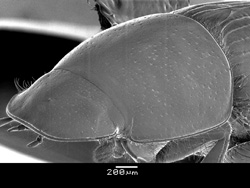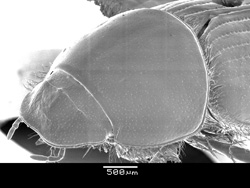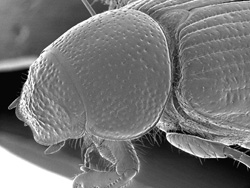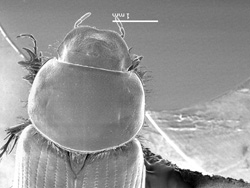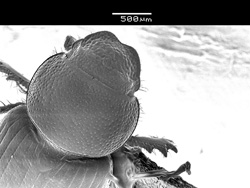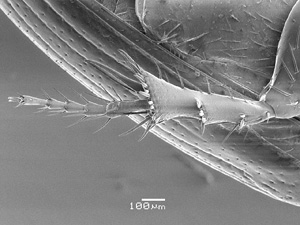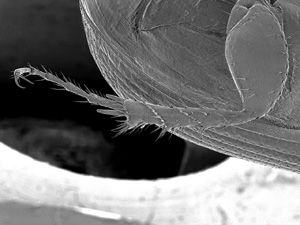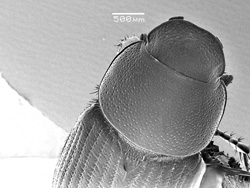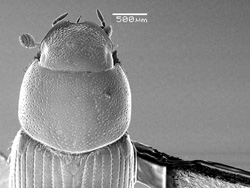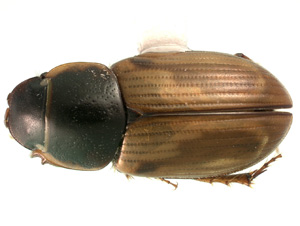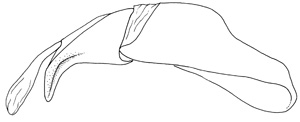|
|
| |
81(80).
.
.
|
Head and body somewhat flattened (Fig. 122). Head surface smooth, finely punctate, lacking distinct tubercles or ridges |
.
.
82 |
| |
81'.
.
.
.
|
Head and body robust (Fig. 123-124), more Psammodius‑like. Head surface usually coarsely punctate and rugose, usually with distinct tubercles or frontal ridge |
|
|
|
|
Figure 122. Flaviellus gordoni. |
Figure 123. Ballucus barri. |
|
|
|
Figure 124. Xeropsamobeus mohavei. |
|
| |
|
| |
82(81).
.
.
.
|
Elytron setose laterally and on declivity, setae sometimes indistinct (Fig. 125). Male protibial spur long, projecting beyond anterior protibial tooth. Central and western North America and Mexico |
.
.
Drepanocanthoides Schmidt |
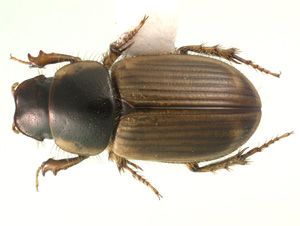 Figure 125. Drepanocanthoides walshi.
Figure 125. Drepanocanthoides walshi. |
82'.
.
.
|
Elytron lacking setae laterally and on apical declivity. Male protibial spur short, not surpassing protibial apical tooth. Widespread |
|
|
| |
|
| |
83(81).
.
.
.
|
Clypeus smooth, shiny, broadly rounded each side of emargination (Fig. 126). Pronotal fringe dense. Body length 6 mm or more. Northwestern North America to Nebraska |
.
.
Ballucus Gordon and Skelley (in part) |
| |
83'.
.
.
.
.
|
Clypeus usually rugose to granulate, rounded to distinctly toothed each side of emargination (Fig. 127). Pronotal fringe usually not dense. Body length 3‑6 mm. Prairie states and southwestern North America and Mexico |
|
|
|
|
Figure 126. Ballucus barri. |
Figure 127. Scabrostomus siccatus. |
|
| |
|
| |
84(83).
.
.
.
.
.
.
|
Metatibia with basal tarsomere distinctly shorter than superior spur (Fig. 128); and/or metatibia thickened, evenly widened to broad apex. Metatibial fringe with long spinules usually less than 2 times longer than short spinules. Pronotum dark or pale, elytron pale. Most species detritivores in sandy soils. Southern and western US |
.
.
.
..
.
Xeropsamobeus Saylor |
| |
84'.
.
.
.
.
.
.
|
Metatibia with basal tarsomere equal to or longer than superior spur (Fig. 129). Metatibia alway slender, apex not as abruptly widened at apex. Metatibial apical fringe with long spinules more than 3 times longer than short spinules. Pronotum dark, elytra pale. Most species pocket gopher associates. Southern Alberta to Wisconsin, central and southern US |
|
|
|
|
Figure 128. Xeropsamobeus doyeni. |
Figure 129. Scabrostomus parapeculiosus, male. |
|
| |
|
| |
85(83).
.
.
.
.
.
|
Pronotum with complete, long, sparse setal fringe (Fig. 130). Body robust, black, elytra sometimes dark brown or with lighter markings. Pronotal disc only with coarse punctures, widely and irregularly spaced. Clypeus weakly emarginate. Northwestern North America |
.
.
Phaeaphodius Reitter (in part) |
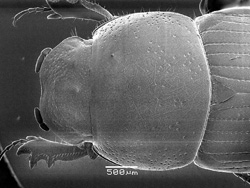 Figure 130. Phaeaphodius rectus
Figure 130. Phaeaphodius rectus. |
85'.
.
.
.
.
|
Pronotum with or without visible lateral setae; if setae visible then short or incomplete along length of margin. Body color variable. Pronotal disc usually with punctures evenly spaced, often of two sizes. Clypeus emarginate or not |
|
|
| |
|
| |
86(85).
.
.
.
|
Pronotum broad, usually explanate, often reflexed, with short, complete fringe of setae (Fig. 131). Male parameres with distinct dorsal or apical lobe. Western North America |
.
Agoliinus
Schmidt
(in part) |
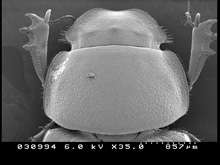 Figure 131. Agoliinus aquilonarius
Figure 131. Agoliinus aquilonarius. |
86'.
.
.
.
|
Pronotum not explanate, occasionally broad, lacking setal fringe or with occasional setae visible. Male parameres with or without apical lobe [from this point, dorsal lobe on paramere present only in Agoliinus] |
|
|
| |
|
| |
87(86).
.
.
.
.
|
Elytron distinctly bicolored, with dark contrasting spots on a yellowish background (Fig. 132), or apex distinctly paler than base. Elytron with lateral fold lacking setae near base, few setae present at pronotal juncture. Body small, length less than 5 mm |
.
.
.
Pardalosus Gordon and Skelley (in part) |
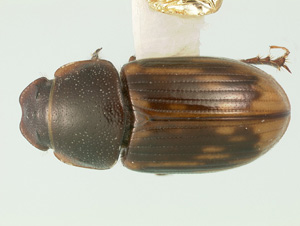 Figure 131. Pardalosus neodistinctus.
Figure 131. Pardalosus neodistinctus. |
87'.
.
.
.
|
Elytron not distinctly bicolored; if bicolored, then lateral fold with distinct setae near base in addition to those at pronotal juncture. Body length variable, often more than 5 mm |
|
|
| |
|
| |
88(87).
.
.
.
|
Clypeus with sparse setal fringe laterad of angulations (Fig. 133). Body entirely black dorsally, often with venter yellow or yellow‑orange. North America and Mexico |
.
.
Pseudagolius Schmidt (in part) |
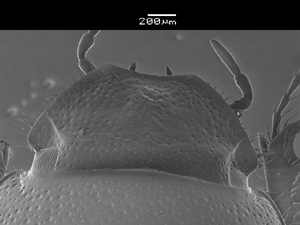
XFigure 133. Pseudagolius coloradensis.
|
88'.
.
|
Clypeus lacking setal fringe. Body with dorsal color variable, venter never yellow‑orange |
|
|
| |
|
| |
89(88).
.
|
Clypeus with median frontal tubercle AND anterior margin distinctly angulate to toothed (Fig. 134) |
.
98 |
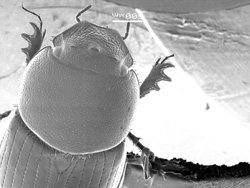 Figure 134. Oscarinus texensis.
Figure 134. Oscarinus texensis. |
89'.
.
.
|
Clypeus lacking above combination. Median frontal tubercle present or not. Clypeal margin occasionally angulate, rarely distinctly toothed |
|
|
| |
|
| |
90(89).
.
.
|
Clypeal surface granulate (Fig. 135). Southeastern North America
. |
Scabrostomus Gordon and Skelley (in part) |
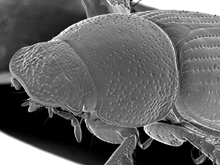 Figure 135. Scabrosomus bakeri.
Figure 135. Scabrosomus bakeri. |
90'.
|
Clypeal surface not granulate, often densely, coarsely punctate. Widespread |
|
|
| |
|
| |
91(90).
.
.
|
Elytron distinctly bicolored or pale, contrasting with pronotum. Elytron occasionally with distinct pubescence on surface or declivity |
.
.
92 |
| |
91'.
.
.
|
Elytron at most with vague pattern, not contrasting in color with pronotum. Elytron never with distinct pubescence on surface or declivity |
|
|
| |
|
| |
92(91).
.
.
|
Clypeal apex nearly truncate or slightly emarginate (Fig. 136), lateral angles broadly rounded, lateral clypeal margin rounded to frontal lobe |
.
.
93 |
| |
92'
.
.
|
Clypeal apex distinctly emarginate medially (Fig. 137), lateral angles narrowly rounded, lateral clypeal margin straight or sinuate |
|
|
|
|
Figure 136. Melinopterus femoralis, female. |
Figure 137. Oscarinus stuesseyi. |
|
| |
|
| |
93(92).
.
.
|
Elytron with distinct black markings (Fig. 138). Elytron lacking distinct dorsal pubescence
. |
Chilothorax Motschulsky (in part) |
| |
93'.
.
.
|
Elytron entirely yellowish, or yellowish with single, large, vague central mark (Fig. 139). Elytral declivity and occasionally disc distinctly pubescent |
|
|
|
|
Figure 138. Melinopterus prodromus, female. |
Figure 139. Melinopterus prodromus, female. |
|
| |
|
| |
94(91).
.
|
Head lacking distinct median frontal tubercle. Body usually reddish‑brown |
.
95 |
| |
94'.
.
|
Head with distinct median frontal tubercle. Body usually black |
|
|
| |
|
| |
95(94).
.
.
|
Pronotum distinctly depressed before hind angle. Pronotal base thickly bordered. Male apical protibial spur lacking (female unknown). Brazil |
Ferrerianus Dellacasa, Gordon and Dellacasa |
| |
95'.
.
.
.
|
Pronotum depressed before hind angle or not. Pronotal base thinly to moderately bordered. Male and female apical protibial spur present. North America to Mexico |
|
|
| |
|
| |
96(95).
.
.
|
Meso‑ and metatibial apical spinules relatively short and unequal, not differing in length by more than half. Body black or nearly so, usually robust |
.
.
98 |
| |
96'.
.
.
|
Meso‑ and metatibial apical spinules long and unequal, differing in length by more than half. Body usually brown or reddish, usually more flattened |
|
|
| |
|
| |
97(94).
.
.
.
.
|
Male and female protibial spurs long, surpassing anterior protibial tooth, female spur only slightly surpassing. Pronotal punctures evenly distributed, nearly uniform in size. Elytral intervals flat. Body black. Eastern North America |
.
.
Lechorodius Gordon and Skelley (in part) |
| |
97'.
.
.
.
.
|
Lacking above combination of characters. Protibial spurs variable, usually not surpassing protibial tooth or only in males. Pronotal punctures often of two distinct sizes. Elytral intervals usually convex. Color black, red or brown, often with elytral spots |
|
|
| |
|
| |
98(71', 89, 92', 96, 97').
.
.
.
.
.
|
Length usually less than 5.0 mm. Body short, robust; dorsal color uniformly black or brown, rarely entirely red. Pronotum robust, dorsum evenly convex in anterior view. Male inferior mesotibial spur unmodified. Male genitalia not strongly curved in lateral view, apex dorsoventrally flattened, without dorsal appendage (Fig. 140). Prairie states, southwestern and eastern North America, and Mexico |
.
.
.
.
.
.
Oscarinus Gordon and Skelley (in part) |
| |
98'.
.
.
.
.
.
.
|
Length usually more than 5.0 mm. Body elongate, robust; dorsal color variable, elytron often speckled. Pronotum not as robust, with dorsum weakly flattened in anterior view. Male inferior mesotibial spur modified. Male genitalia curved in lateral view, with dorsal appendage (Fig. 141). Widespread North America and Mexico, but not southeastern US |
|
|
|
|
Figure 140. Oscarinus floridanus. |
Figure 141. Agoliinus leopardus. |
|
| |

